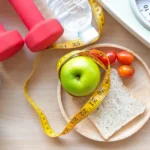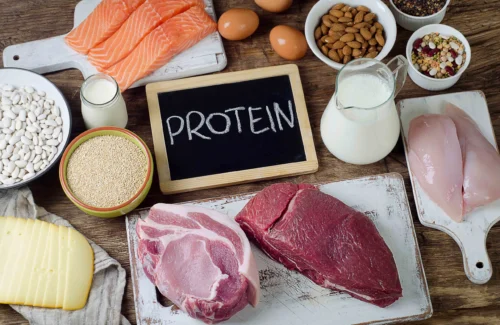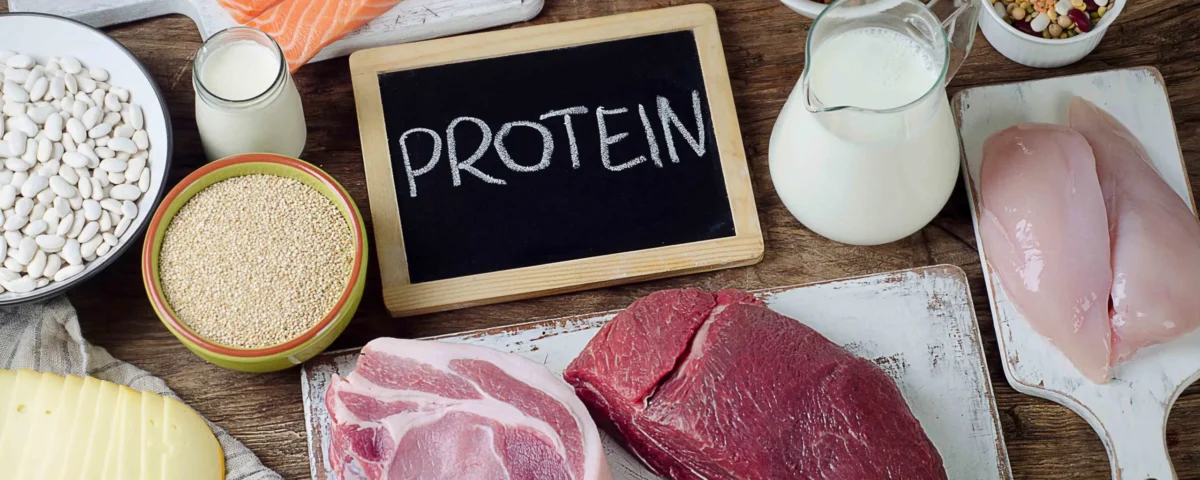
15 Healthy Snacks for Pregnant Women Backed by Experts
September 25, 2025
Healthy Weight Loss in Canada: An Evidence-Based Guide by SDnutrition
October 10, 2025When it comes to fueling young athletes, protein plays a central role. For teenagers, the body is not only working hard to recover from practices and games, but it’s also still growing. That means their protein needs are higher compared to most adults. The right type and amount of protein helps teenage athletes build muscle, maintain energy, and recover faster—giving them the strength and stamina they need both on and off the field.
But finding the best protein for teenage athletes isn’t just about powders or supplements. It’s about real, balanced foods that fit into their busy school and training schedules. And because every teen is different, what works for one may not work for another.
At SD Nutrition Clinic, we support Canadian families with personalized, evidence-based guidance. Whether your teenager is chasing a scholarship, playing recreational sports, or simply wants to stay healthy and strong, we help you design a protein strategy that’s safe, practical, and effective.
Whether you’re a young athlete, a weekend runner, or a professional competitor, our Sports Nutrition Services deliver customized meal and protein strategies to boost performance, recovery, and long-term health.
Why Protein is Important for Teenage Athletes
Protein is more than just a “muscle food”—for teenagers, it’s a foundation for healthy growth. Here’s why it matters so much:
- Growth and muscle development
During adolescence, teens experience rapid growth spurts. Protein provides the building blocks (amino acids) needed to support both bone and muscle development, helping young athletes grow stronger while preventing imbalances. - Energy demands in adolescence
Teen athletes burn through calories quickly, especially during practices and competitions. Protein helps stabilize energy levels by slowing digestion and working alongside carbs to fuel muscles more effectively. Without enough protein, fatigue and slower performance are common. - Injury prevention and faster recovery
Sports put stress on developing bodies. Adequate protein helps repair muscle fibres, strengthen tissues, and speed up recovery after intense training. This not only improves performance but also lowers the risk of overuse injuries, which are common among young athletes.
For parents, ensuring your teen gets the best protein for teenage athletes means focusing on whole food sources first (lean meats, eggs, dairy, legumes, nuts, and seeds), with supplements only if needed and under professional guidance.
How Much Protein Do Teenage Athletes Need?
When it comes to fueling young athletes, the question most parents ask is, “How much protein does my teen actually need?” The truth is, teenagers aren’t just “mini adults.” Their bodies are in a unique growth phase—building muscle, bones, hormones, and energy stores—all while balancing the demands of school, sports, and recovery.
- Daily recommended intake
According to Health Canada and sports nutrition experts, most teenage athletes need around 1.2 to 2.0 grams of protein per kilogram of body weight per day. For example, a 60 kg (132 lb) teen athlete would require 72–120 grams of protein daily, depending on training intensity and sport. - Differences by age, gender, and sport intensity
Boys often need slightly higher amounts due to lean muscle development and faster growth rates, while girls may require more careful balance with iron and calcium to support bone health and menstrual needs. Endurance athletes (like swimmers or runners) need protein for recovery, while strength-based athletes (like hockey players or wrestlers) often fall on the higher end of the protein range - Myths vs. science
A common misconception is that “more protein = more muscle.” In reality, the body can only use a certain amount at a time. Excess protein doesn’t mean bigger muscles—it can actually put stress on the kidneys or displace other important nutrients. For teenage athletes, balance is key:the best protein for teenage athletes comes from spreading intake across the day with real, nutrient-dense foods.

Best Natural Protein Sources for Teen Athletes
Instead of relying only on powders or supplements, whole foods provide not just protein but also essential vitamins and minerals. Here are some of the best protein for teenage athletes from natural sources:
Lean Meats and Poultry
Chicken, turkey, and lean cuts of beef are rich in high-quality protein and essential amino acids. They also provide iron and zinc, crucial for oxygen transport and muscle function.
Fish and Seafood
Canadian favourites like salmon, trout, and tuna deliver protein along with omega-3 fatty acids that support brain function and reduce inflammation. These are excellent choices for recovery days.
Dairy Products
Milk, yogurt, and cheese are convenient, calcium-rich options that also supply vitamin D. A glass of milk or Greek yogurt snack can easily boost protein intake while strengthening bones.
Eggs as a Complete Protein
Eggs are considered a “gold standard” protein because they contain all nine essential amino acids. They’re versatile, affordable, and perfect for breakfast or post-training meals.
Plant-Based Proteins
For vegetarian or flexitarian teens, beans, lentils, tofu, and quinoa provide excellent alternatives. Pairing plant proteins (like rice and beans) ensures they get the full spectrum of amino acids.
Nuts and Seeds
Almonds, chia, flaxseeds, and pumpkin seeds add both protein and healthy fats. They’re easy to pack in a gym bag as a snack and can also support energy levels during long practices.
The best protein for teenage athletes is a mix of these natural, whole-food sources, spread throughout the day in balanced meals and snacks. Supplements can help in certain cases, but they should never replace real food.
Protein Snacks and Meals for Young Athletes
For teenagers who are constantly on the go, snacks and meals need to be quick, affordable, and nutrient-dense. The goal is to give them steady energy throughout the day while also meeting protein needs for muscle repair and growth.
- Quick, affordable snacks: Trail mix (nuts, seeds, dried fruit), smoothies with milk or yogurt, hard-boiled eggs, cheese sticks, and roasted chickpeas are all portable and budget-friendly. These snacks can easily deliver 10–15 g of protein on the go.
- High-protein breakfasts: A protein-packed breakfast sets the tone for the day. Great options include overnight oats with Greek yogurt and chia seeds, whole-grain toast with eggs and avocado, or a parfait layered with fruit, granola, and yogurt.
- Post-workout meals for recovery: Within an hour after training, aim for 20–25 g of protein paired with carbs to replenish glycogen. Options include chicken wraps, salmon with rice and veggies, or a smoothie made with milk, oats, banana, and peanut butter.
👉 Remember: The best protein for teenage athletes doesn’t always come from powders—it’s often found in simple, home-prepared foods that families can make without breaking the budget.
Gaining weight doesn’t have to mean eating unhealthy foods. Our Healthy Weight Gain programs focus on balanced, nutrient-rich plans that support muscle growth and overall wellness in a safe, sustainable way.
Protein Supplements and Shakes: Are They Safe for Teens?
Protein powders and shakes are popular, but parents often worry: “Are they safe for my teenager?” The evidence is clear—most teens can get enough protein from real food. Supplements may only be useful in specific cases, such as when appetite is low, schedules are busy, or dietary restrictions limit intake.
- Evidence-based guidance: Whey protein (derived from milk) is one of the most studied and safe options when used in moderation. It provides a complete amino acid profile that supports recovery.
- When (and if) supplements are needed: If a teen struggles to hit their protein target through food, a simple whey, casein, or plant-based protein can help fill the gap. They should never replace meals but act as a convenient backup.
- Risks of over-reliance: Too much reliance on powders can displace important nutrients from real foods. Many commercial products also contain added sugars, stimulants, or artificial ingredients that teens don’t need.
- Safe Canadian options: Always look for Health Canada–approved products with an NPN number and third-party testing (e.g., NSF, Informed Sport). Avoid “mass gainer” or “pre-workout” style powders.
The best protein for teenage athletes should come from whole foods first. Supplements can be safe and effective if carefully chosen and used responsibly.
Looking to lose weight without strict diets? Our Healthy Weight Loss approach combines practical meal planning, lifestyle tips, and evidence-based strategies to help you reach your goals while staying energized.
Risks of Excessive Protein Intake in Teenagers
More protein doesn’t always mean better performance. In fact, too much can create problems for growing bodies.
- Kidney strain and hydration issues: Excessive protein may increase the workload on the kidneys and lead to dehydration if teens don’t drink enough water.
- Nutrient imbalances: If protein intake is too high, it can crowd out other essential nutrients like carbohydrates (the body’s main fuel for sports) and healthy fats (vital for hormones and brain development).
- The importance of balance: Teens need a mix of protein, carbs, healthy fats, vitamins, and minerals to perform at their best. Sports nutrition is about the whole picture, not just one nutrient.
Parents should focus less on hitting the highest protein numbers and more on ensuring variety, balance, and timing. The best protein for teenage athletes is part of a well-rounded plan that fuels growth, supports recovery, and keeps them healthy long-term.
Special Diet Considerations
Not every teenage athlete follows the same diet. Some have unique needs that require extra planning to make sure they’re still getting the best protein for teenage athletes in a safe, balanced way.
Vegetarian and Vegan Teens: Protein Strategies
Plant-based diets can provide plenty of protein if meals are planned well. Good options include lentils, beans, tofu, tempeh, quinoa, and soy milk. Pairing plant proteins (like rice and beans) helps deliver all essential amino acids. Vegan teens may also need fortified foods for Vitamin B12, calcium, and iron to support athletic growth.
Teens with Food Allergies (Dairy, Gluten, Nuts)
Food allergies can make it tricky to meet protein needs, but there are still safe alternatives:
- Dairy-free: soy or pea protein milk, coconut yogurt with added protein, or fortified oat beverages.
- Gluten-free: quinoa, buckwheat, rice, and gluten-free oats.
- Nut-free: seeds (pumpkin, sunflower, chia) and seed butters.
The key is variety—rotating safe protein sources ensures teens don’t miss out on vital nutrients.
Athletes with Medical Conditions (e.g., Diabetes)
Teen athletes with conditions like diabetes need carefully balanced meals. Protein helps stabilize blood sugar when paired with complex carbs. Lean meats, dairy, beans, and eggs can all fit into a diabetes-friendly meal plan. Consulting a dietitian ensures the athlete’s diet supports both medical needs and performance goals.
Canadian Context: Local and Affordable Protein Sources
Nutrition has to be practical, not just theoretical. Families in Canada can take advantage of local foods that are both nutritious and affordable.
Canadian Superfoods Rich in Protein
- Salmon and trout: abundant in Canadian waters, offering protein and omega-3s.
- Lentils and chickpeas: grown widely in Saskatchewan and Alberta, great budget-friendly protein.
- Dairy: Canadian milk, cheese, and yogurt are affordable, high-protein staples.
Grocery Shopping Tips for Student Athletes on a Budget
- Buy in bulk: large bags of oats, beans, and frozen fish are more cost-effective.
- Choose store-brand Greek yogurt or cottage cheese for affordable protein.
- Stock up on frozen vegetables and berries—they’re just as nutritious as fresh and often cheaper.
Using the Canada Food Guide for Youth Athletes
Health Canada’s Food Guide highlights balanced eating patterns: half your plate fruits/veggies, a quarter whole grains, and a quarter protein foods. For athletes, protein needs may be slightly higher, but the principles still apply—variety and balance matter more than supplements.
👉 The best protein for teenage athletes in Canada isn’t always about expensive powders; it’s about smart grocery choices that deliver real nutrition.
FAQs – Protein for Teenage Athletes
Do teenagers need protein shakes?
Not always. Most teens can get enough protein from food. Shakes can help if schedules are hectic or appetite is low, but they’re not essential.
What’s the best post-game recovery meal?
A balanced plate with protein and carbs works best. Examples: grilled chicken with rice and veggies, salmon with quinoa and spinach, or a smoothie with milk, banana, oats, and peanut butter.
Are protein bars safe for teens?
Some are fine, but many are loaded with sugar or additives. Look for options with at least 10 g protein, under 10 g sugar, and simple ingredients. Whole foods are still the better choice.
How much protein is too much?
More isn’t always better. Consistently going way above 2 g/kg body weight daily can lead to kidney strain, nutrient imbalances, and dehydration. Focus on balance, not excess.
Do teenage athletes need protein shakes?
Not always. Most teens can get enough protein from real foods like eggs, dairy, fish, beans, and nuts. Protein shakes may be useful only when schedules are busy, appetite is low, or specific needs aren’t met through meals.
What are the best protein foods for young athletes?
The best options include lean meats, chicken, fish, eggs, dairy (milk, cheese, yogurt), beans, lentils, tofu, nuts, and seeds. These foods provide protein plus essential vitamins and minerals needed for growth and performance.
How much protein should a 15-year-old athlete eat daily?
Most teenage athletes need 1.2–2.0 grams of protein per kilogram of body weight each day. For a 15-year-old weighing 60 kg, that equals 72–120 g of protein, spread across meals and snacks.
Are protein bars safe for teenage athletes?
Some protein bars are safe, but many contain too much sugar, caffeine, or additives. Look for simple, natural options with at least 8–10 g of protein and under 10 g of sugar. Whole foods remain the better choice.
Can too much protein harm teenagers?
Yes. Consistently eating far more protein than needed can strain the kidneys, cause dehydration, and displace other vital nutrients like carbs and healthy fats. Balance and variety are key for teenage athletes.
When it comes to fueling young athletes, the best protein for teenage athletes doesn’t come from quick fixes or overloading on shakes. It comes from a balance of whole foods—lean meats, fish, eggs, dairy, legumes, nuts, and seeds—supported by the right timing and variety. Protein is vital for growth, energy, recovery, and injury prevention, but it works best as part of a full sports nutrition plan that includes carbs, healthy fats, and hydration.
At SD Nutrition Clinic, we know that every teen athlete is different. Training schedules, school demands, and dietary preferences all play a role in shaping their needs. That’s why we design personalized sports nutrition plans that are practical, safe, and often covered by Canadian insurance.
Ready to give your teen the fuel they need to perform their best?
✨ Ready to take the next step toward better health and performance? At SD Nutrition Clinic, we create personalized nutrition plans tailored to your goals whether it’s weight management, pregnancy wellness, or sports performance. Don’t wait to start your journey—Book Your Consultation Now
and get expert guidance designed just for you.


